Data-Driven Analysis of Construction Safety Dynamics: Regulatory Frameworks, Evolutionary Patterns, and Technological Innovations
Abstract
1. Introduction
2. Methodology
2.1. Data Collection
2.2. Quantitative Trend Analysis
3. Results
3.1. Research Trends and Global Contributions
3.2. Thematic Evolution and Author Keyword Co-Occurrence Analysis
3.2.1. Subperiod 1972–1985
3.2.2. Subperiod 1986–1995
3.2.3. Subperiod 1996–2005
3.2.4. Subperiod 2006–2015
3.2.5. Subperiod 2016–2025
4. Discussion
4.1. Major Regulatory Frameworks in Construction Safety
4.2. Chronological Shifts in Construction Safety Research Themes
4.3. Analysis of Evolutionary Patterns Across Historical Periods
4.4. Summary
5. Future Directions
5.1. AI-Enhanced Safety Management and Predictive Hazard Detection
5.2. Digital Twins and IoT-Enabled Real-Time Safety Monitoring
5.3. Automation, Robotics, and Wearable Technologies for Risk Reduction
5.4. Blockchain and Smart Contracts for Safety Compliance and Data Integrity
6. Conclusions
Author Contributions
Funding
Data Availability Statement
Conflicts of Interest
References
- Jukka, P.H.; Tan, T.; Kiat, B. Global Estimates of Occupational Accidents and Work-Related Illnesses 2017. 2017. Available online: www.wsh-institute.sg (accessed on 21 March 2025).
- Bureau of Labor Statistics. Industries at a Glance: Construction: NAICS 23; U.S. Department of Labor: Washington, DC, USA. Available online: https://www.bls.gov/iag/tgs/iag23.htm#about (accessed on 21 March 2025).
- Bureau of Labor Statistics. National Census of Fatal Occupational Injuries in 2023; U.S. Department of Labor: Washington, DC, USA. Available online: https://www.bls.gov/news.release/cfoi.t02.htm (accessed on 21 March 2025).
- Lingard, H.; Rowlinson, S. Occupational Health and Safety in Construction Project Management; Routledge: London, UK, 2017. [Google Scholar]
- Leigh, J.P. Economic burden of occupational injury and illness in the United States. Milbank Q. 2011, 89, 728–772. [Google Scholar] [CrossRef]
- Zhou, Z.; Goh, Y.M.; Li, Q. Overview and analysis of safety management studies in the construction industry. Saf. Sci. 2015, 72, 337–350. [Google Scholar] [CrossRef]
- Alwashah, Z.; Sweis, G.J.; Abu Hajar, H.; Abu-Khader, W.; Sweis, R. Awareness and Willingness to Adopt Construction 4.0 Technologies: Evidence from Jordan. Engineering, Construction and Architectural Management. 2025. Available online: https://www.emerald.com/insight/content/doi/10.1108/ECAM-10-2024-1436/full/html (accessed on 15 January 2025).
- Mazlina Zaira, M.; Hadikusumo, B.H.W. Structural equation model of integrated safety intervention practices affecting the safety behaviour of workers in the construction industry. Saf. Sci. 2017, 98, 124–135. [Google Scholar] [CrossRef]
- Zupic, I.; Čater, T. Bibliometric Methods in Management and Organization. Organ. Res. Methods 2015, 18, 429–472. [Google Scholar] [CrossRef]
- Bhagwat, K.; Delhi, V.S.K. A systematic review of construction safety research: Quantitative and qualitative content analysis approach. Built Environ. Proj. Asset Manag. 2022, 12, 243–261. [Google Scholar] [CrossRef]
- Jin, R.; Zou, P.X.W.; Piroozfar, P.; Wood, H.; Yang, Y.; Yan, L.; Han, Y. A science mapping approach based review of construction safety research. Saf. Sci. 2019, 113, 285–297. [Google Scholar] [CrossRef]
- Liang, H.; Zhang, S.; Su, Y. The structure and emerging trends of construction safety management research: A bibliometric review. Int. J. Occup. Saf. Ergon. 2020, 26, 469–488. Available online: https://www.tandfonline.com/doi/abs/10.1080/10803548.2018.1444565 (accessed on 2 March 2025). [CrossRef]
- Alder, S. Why Was OSHA Created? 2023. Available online: https://www.hipaajournal.com/why-was-osha-created/ (accessed on 26 February 2025).
- Olimat, H.; Liu, H.; Abudayyeh, O. Enabling Technologies and Recent Advancements of Smart Facility Management. Buildings 2023, 13, 1488. Available online: https://www.mdpi.com/2075-5309/13/6/1488/htm (accessed on 15 March 2025). [CrossRef]
- AlTalhoni, A.; Liu, H.; Abudayyeh, O. Forecasting Construction Cost Indices: Methods, Trends, and Influential Factors. Buildings 2024, 14, 3272. [Google Scholar] [CrossRef]
- Donthu, N.; Kumar, S.; Mukherjee, D.; Pandey, N.; Lim, W.M. How to conduct a bibliometric analysis: An overview and guidelines. J. Bus. Res. 2021, 133, 285–296. [Google Scholar] [CrossRef]
- van Eck, N.J.; Waltman, L. Software survey: VOS viewer, a computer program for bibliometric mapping. Scientometrics 2010, 84, 523–538. [Google Scholar] [CrossRef] [PubMed]
- Lozano, S.; Calzada-Infante, L.; Adenso-Díaz, B.; García, S. Complex network analysis of keywords co-occurrence in the recent efficiency analysis literature. Scientometrics 2019, 120, 609–629. [Google Scholar] [CrossRef]
- Steinhauser, V.P.S.; da Rocha, A.; de Oliveira Paula, F. Institutional Theory and International Entrepreneurship: A Review. Internext 2022, 17, 264–283. Available online: https://internext.espm.br/internext/article/view/684 (accessed on 5 March 2023). [CrossRef]
- Shin, J.; Kim, Y.; Kim, C. The perception of occupational safety and health (Osh) regulation and innovation efficiency in the construction industry: Evidence from South Korea. Int. J. Environ. Res. Public Health 2021, 18, 2334. [Google Scholar] [CrossRef]
- Hinze, J. Human Aspects of Construction Safety. J. Constr. Div. 1981, 107, 61–72. [Google Scholar] [CrossRef]
- Zhou, W.; Whyte, J.; Sacks, R. Construction safety and digital design: A review. Autom. Constr. 2012, 22, 102–111. [Google Scholar] [CrossRef]
- Zhang, S.; Boukamp, F.; Teizer, J. Ontology-based semantic modeling of construction safety knowledge: Towards automated safety planning for job hazard analysis (JHA). Autom. Constr. 2015, 52, 29–41. [Google Scholar] [CrossRef]
- Meng, Q.; Peng, Q.; Li, Z.; Hu, X. Big Data Technology in Construction Safety Management: Application Status, Trend and Challenge. Buildings 2022, 12, 533. [Google Scholar] [CrossRef]
- MacCollum, D.V. Construction Safety Planning; John Wiley & Sons: Hoboken, NJ, USA, 1995. [Google Scholar]
- Mannan, M.S.; Reyes-Valdes, O.; Jain, P.; Tamim, N.; Ahammad, M. The Evolution of Process Safety: Current Status and Future Direction. Annu. Rev. Chem. Biomol. Eng. 2016, 7, 135–162. [Google Scholar] [CrossRef]
- Duckworth, R.M. Maintenance and works’ engineering. Water Pollut. Control 1976, 75, 124–133. [Google Scholar]
- Gray, W.B. The impact of OSHA and EPA regulation on productivity. Am. Econ. Rev. 1984, 77, 998–1006. [Google Scholar]
- Cohen, H.H.; Compton, D.M. Fall accident patterns: Characterization of most frequent work surface-related injuries. Prof. Saf. J. Am. Soc. Saf. Eng. 1982, 27, 16–22. [Google Scholar]
- Tucker, M.B. Safety in Construction. Highw. Eng. 1983, 30, 15–19. [Google Scholar]
- Nelson, N.A.; Kaufman, J.; Kalat, J.; Silverstein, B. Falls in construction: Injury rates for OSHA-inspected employers before and after citation for violating the Washington State Fall Protection Standard. Am. J. Ind. Med. 1997, 31, 296–302. [Google Scholar] [CrossRef]
- Martínez Aires, M.D.; Rubio Gámez, M.C.; Gibb, A. Prevention through design: The effect of European Directives on construction workplace accidents. Saf. Sci. 2010, 48, 248–258. [Google Scholar] [CrossRef]
- Vigezzi, M.; Brown, S.; Deitch, N.; Phillips, J. VPP: Partnership for Safety and Health Excellence. In Proceedings of the ASSE Professional Development Conference and Exposition, ASSE, Baltimore, MD, USA, 13–16 June 1999. [Google Scholar]
- Björk, B.C.; Laakso, M. CAD standardisation in the construction industry—A process view. Autom. Constr. 2010, 19, 398–406. [Google Scholar] [CrossRef]
- Tavakoli, A.; Klika, K.L. Construction management with AUTOCAD. J. Manag. Eng. 1991, 7, 267–278. Available online: https://ascelibrary.org/doi/abs/10.1061/(ASCE)9742-597X(1991)7:3(267) (accessed on 7 April 2025). [CrossRef]
- David LeBlond, B.; Owen, F.; Edward Gibson Jr, Z.G.; Haas, C.T.; Travers, A.E. Control Improvement for Advanced Construction Equipment. J. Constr. Eng. Manag. 1998, 124, 289–296. Available online: https://ascelibrary.org/doi/abs/10.1061/%28ASCE%290733-9364%281998%29124%3A4%28289%29 (accessed on 12 February 2025). [CrossRef]
- Haas, C.; Skibniewski, M.; Budny, E. Robotics in Civil Engineering. Comput.-Aided Civil. Infrastruct. Eng. 1995, 10, 371–381. Available online: https://onlinelibrary.wiley.com/doi/full/10.1111/j.1467-8667.1995.tb00298.x (accessed on 18 February 2025). [CrossRef]
- Hale, O. Evaluation of Excavation Cave-in Accidents Before and After the 1990 Revisions to the OSHA Excavation Regulations. Master’s Thesis, University of Tennesse, Knoxville, TN, USA, 1996. Available online: https://trace.tennessee.edu/utk_gradthes/5794 (accessed on 4 March 2023).
- Hemami, A. Fundamental Analysis of Automatic Excavation. J. Aerosp. Eng. 1995, 8, 175–179. [Google Scholar] [CrossRef]
- Goldenhar, L.; Schulte, P. Intervention research in occupational safety and health. J. Occup. Med. 1994, 36, 763–775. Available online: https://www.researchgate.net/publication/15266980_Intervention_research_in_occupational_safety_and_health (accessed on 28 January 2025). [PubMed]
- Bennett, B.; Deitch, N. OSHA’s Voluntary Protection Programs (VPP) Continue to Bring Value; OnePetro: Richardson, TX, USA, 2011. [Google Scholar]
- Lange, J.H. Hazardous waste training: Meeting OSHA and practical requirements. J. Pa. Acad. Sci. 1992, 65, 145–152. [Google Scholar]
- Levin, S.M.; Goldberg, M. Clinical Evaluation and Management of Lead-Exposed Construction Workers. Am. J. Ind. Med. 2000, 37, 23–43. Available online: https://onlinelibrary.wiley.com/terms-and-conditions (accessed on 7 February 2025). [CrossRef]
- de Boer, C.; Catsburg, I. A Report: The Impact of Nuclear Accidents on Attitudes Toward Nuclear Energy on JSTOR. Public Opin. Q. 1988, 52, 254–261. Available online: https://www.jstor.org/stable/2749279?casa_token=NUWwb2aC638AAAAA%3Ai2aEu8YIDglQZC-XwQmhrh92rLg_X7WmkHszQxtVUkcmq2ccUvxvNenML4-J64I56SbTZiGCKwK4bIULgYzLEITiFp08RjcM7Qxiw5AVg11zZVS4NA&seq=1 (accessed on 12 February 2025). [CrossRef]
- Moray, N.P.; Huey, B.M. Human Factors Research and Nuclear Safety; National Academies Press: Washington, DC, USA, 1988. [Google Scholar]
- Hatsuda, T.; Sasaki, I.; Mitsuhashi, R. Design and results of operating intelligent crane control system with real-time three-dimensional processing technology. Electron. Commun. Jpn. Part I Commun. (Engl. Transl. Denshi Tsushin Gakkai Ronbunshi) 1997, 80, 45–57. [Google Scholar] [CrossRef]
- McLaughlin, J.; Sreenivasan, S.V.; Haas, C.; Liapi, K. Rapid human-assisted creation of bounding models for obstacle avoidance in construction. Comput.-Aided Civil. Infrastruct. Eng. 2004, 19, 3–15. [Google Scholar] [CrossRef]
- Whitaker, S.M.; Graves, R.J.; James, M.; McCann, P. Safety with access scaffolds: Development of a prototype decision aid based on accident analysis. J. Saf. Res. 2003, 34, 249–261. [Google Scholar] [CrossRef] [PubMed]
- Chantawit, D.; Hadikusumo, B.H.W.; Charoenngam, C.; Rowlinson, S. 4DCAD-Safety: Visualizing project scheduling and safety planning. Constr. Innov. 2005, 5, 99–114. [Google Scholar]
- Assfalg, J.; Del Bimbo, A.; Vicario, E. Using 3D and ancillary media to train construction workers. IEEE MultiMedia 2002, 9, 88–92. Available online: https://ieeexplore.ieee.org/abstract/document/998075 (accessed on 7 April 2025). [CrossRef]
- Shabha, G.; Rudge, D. The long-term importance of education to raise safety levels and the implementation of the CDM regulations in the European building industry. Struct. Surv. 1997, 15, 87–91. [Google Scholar] [CrossRef]
- Elias, A.M.; Herbsman, Z.J. Risk analysis techniques for safety evaluation of highway work zones. Transp. Res. Rec. 2000, 1, 10–17. [Google Scholar] [CrossRef]
- van den Dobbelsteen, A.; de Wilde, S. Space use optimisation and sustainability—Environmental assessment of space use concepts. J. Environ. Manag. 2004, 73, 81–89. [Google Scholar] [CrossRef] [PubMed]
- Yassin, A.S.; Martonik, J.F. The effectiveness of the revised scaffold safety standard in the construction industry. Saf. Sci. 2004, 42, 921–931. [Google Scholar] [CrossRef]
- Shin, M.; Lee, H.S.; Park, M.; Moon, M.; Han, S. A system dynamics approach for modeling construction workers’ safety attitudes and behaviors. Accid. Anal. Prev. 2014, 68, 95–105. [Google Scholar] [CrossRef] [PubMed]
- Lee, H.S.; Lee, K.P.; Park, M.; Baek, Y.; Lee, S. RFID-Based Real-Time Locating System for Construction Safety Management. J. Comput. Civil. Eng. 2012, 26, 366–377. Available online: https://ascelibrary.org/doi/abs/10.1061/%28ASCE%29CP.1943-5487.0000144 (accessed on 8 March 2025). [CrossRef]
- Zhou, Z.; Irizarry, J.; Li, Q. Applying advanced technology to improve safety management in the construction industry: A literature review. Constr. Manag. Econ. 2013, 31, 606–622. Available online: https://www.tandfonline.com/doi/abs/10.1080/01446193.2013.798423 (accessed on 12 March 2025). [CrossRef]
- Su, Y.Y.; Hashash, Y.M.A.; Liu, L.Y. Integration of Construction As-Built Data Via Laser Scanning with Geotechnical Monitoring of Urban Excavation. J. Constr. Eng. Manag. 2006, 132, 1234–1241. Available online: https://ascelibrary.org/doi/abs/10.1061/%28ASCE%290733-9364%282006%29132%3A12%281234%29 (accessed on 25 February 2025). [CrossRef]
- Xie, H.; Tudoreanu, M.E.; Shi, W. Development of a Virtual Reality Safety-Training System for Construction Workers. In Proceedings of the 6th International Conference on Construction Applications of Virtual Reality (CONVR 2006), Orlando, FL, USA, 3–4 August 2006; Available online: https://itc.scix.net/pdfs/ff9b.content.00092.pdf (accessed on 7 April 2025).
- Sacks, R.; Perlman, A.; Barak, R. Construction safety training using immersive virtual reality. Constr. Manag. Econ. 2013, 31, 1005–1017. Available online: https://www.tandfonline.com/doi/abs/10.1080/01446193.2013.828844 (accessed on 6 February 2025). [CrossRef]
- Randall, T. Construction Engineering Requirements for Integrating Laser Scanning Technology and Building Information Modeling. J. Constr. Eng. Manag. 2011, 137, 797–805. Available online: https://ascelibrary.org/doi/abs/10.1061/%28ASCE%29CO.1943-7862.0000322 (accessed on 9 March 2025). [CrossRef]
- Lee, U.K.; Kim, J.H.; Cho, H.; Kang, K.I. Development of a mobile safety monitoring system for construction sites. Autom. Constr. 2009, 18, 258–264. [Google Scholar] [CrossRef]
- Riaz, Z.; Arslan, M.; Kiani, A.K.; Azhar, S. CoSMoS: A BIM and wireless sensor based integrated solution for worker safety in confined spaces. Autom. Constr. 2014, 45, 96–106. [Google Scholar] [CrossRef]
- Zhang, S.; Teizer, J.; Lee, J.K.; Eastman, C.M.; Venugopal, M. Building Information Modeling (BIM) and Safety: Automatic Safety Checking of Construction Models and Schedules. Autom. Constr. 2013, 29, 183–195. [Google Scholar] [CrossRef]
- Elattar, S.M.S. Automation and robotics in construction: Opportunities and challenges. Emir. J. Eng. Res. 2008, 13, 21–26. [Google Scholar]
- Seo, J.; Lee, S.; Kim, J.; Kim, S.K. Task planner design for an automated excavation system. Autom. Constr. 2011, 20, 954–966. [Google Scholar] [CrossRef]
- Seo, J.; Han, S.; Lee, S.; Kim, H. Computer vision techniques for construction safety and health monitoring. Adv. Eng. Inform. 2015, 29, 239–251. [Google Scholar] [CrossRef]
- Bahrainy, H.; Khosravi, H. The impact of urban design features and qualities on walkability and health in under-construction environments: The case of Hashtgerd New Town in Iran. Cities 2013, 31, 17–28. [Google Scholar] [CrossRef]
- Rajendran, S.; Gambatese, J.A.; Behm, M.G. Impact of Green Building Design and Construction on Worker Safety and Health. J. Constr. Eng. Manag. 2009, 135, 1058–1066. [Google Scholar] [CrossRef]
- Scanlon, K.A.; Lloyd, S.M.; Gray, G.M.; Francis, R.A.; Lapuma, P. An Approach to Integrating Occupational Safety and Health into Life Cycle Assessment: Development and Application of Work Environment Characterization Factors. J. Ind. Ecol. 2015, 19, 27–37. Available online: https://onlinelibrary.wiley.com/doi/full/10.1111/jiec.12146 (accessed on 6 March 2025). [CrossRef]
- Slim, Z.Q.D.; Elba, M.V.N.; Eduardo, V.C.L. The importance of occupational safety and health in management systems in the construction industry: Case study of construction in Hermosillo. Cent. East. Eur. J. Manag. Econ. (CEEJME) 2015, 3, 51–69. [Google Scholar]
- Aneziris, O.N.; Topali, E.; Papazoglou, I.A. Occupational risk of building construction. Reliab. Eng. Syst. Saf. 2012, 105, 36–46. [Google Scholar] [CrossRef]
- Fung, I.W.H.; Tam, V.W.Y.; Lo, T.Y.; Lu, L.L.H. Developing a Risk Assessment Model for construction safety. Int. J. Proj. Manag. 2010, 28, 593–600. [Google Scholar] [CrossRef]
- Gilkey, D.P.; Lopez Del Puerto, C.; Keefe Thomas Bigelow, P.; Herron, R.; Rosecrance, J.; Chen, P. Comparative Analysis of Safety Culture Perceptions among HomeSafe Managers and Workers in Residential Construction. J. Constr. Eng. Manag. 2012, 138, 1044–1052. [Google Scholar] [CrossRef]
- Al-Bayati, A.J.; Alghamdi, A.; Al-Bayati, A.J.; Abudayyeh, O. Improving the Safety Culture and Climate of Smaller Construction Firms: A Necessary Addition to the OSH Intervention Model. J. Civ. Eng. Constr. 2023, 12, 187–196. [Google Scholar] [CrossRef]
- Al-Bayati, A.J.; Abudayyeh, O.; Albert, A. Managing active cultural differences in U.S. construction workplaces: Perspectives from non-Hispanic workers. J. Saf. Res. 2018, 66, 1–8. [Google Scholar] [CrossRef]
- Al-Bayati, A.J.; Abudayyeh, O.; Fredericks, T.; Butt, S.E. Managing Cultural Diversity at U.S. Construction Sites: Hispanic Workers’ Perspectives. J. Constr. Eng. Manag. 2017, 143, 04017064. Available online: https://ascelibrary.org/doi/abs/10.1061/%28ASCE%29CO.1943-7862.0001359 (accessed on 12 February 2025). [CrossRef]
- Yuan, L.; Buvens, M. Ergonomic Evaluation of Scaffold Building. Procedia Manuf. 2015, 3, 4338–4341. [Google Scholar] [CrossRef]
- Al-Bayati, A.J.; Al-Kasasbeh, M.; Awolusi, I.; Abudayyeh, O.; Umar, T. Trends of Occupational Fatal and Nonfatal Injuries in Electrical and Mechanical Specialty Contracting Sectors: Necessity for a Learning Investigation System. J. Constr. Eng. Manag. 2021, 147, 04021069. Available online: https://ascelibrary.org/doi/abs/10.1061/%28ASCE%29CO.1943-7862.0002105 (accessed on 24 February 2025). [CrossRef]
- Wright, E.; Wells, L.; Dhingra, E.; Toplis, C. Adapting Ports to the Impacts of Climate Change. In Proceedings of the 13th Triennial International Conference, Seattle, WA, USA, 25–28 August 2013; pp. 1245–1254. [Google Scholar]
- Xiang, J.; Bi, P.; Pisaniello, D.; Hansen, A. Health Impacts of Workplace Heat Exposure: An Epidemiological Review. Ind. Health 2014, 52, 91–101. [Google Scholar] [CrossRef]
- Louw, L.A.; Schaap, P. Categories of Human Risk Factors Which Impact on the Psychological Fitness of Construction Workers: A Review of the Evidence. J. Psychol. Afr. 2013, 23, 589–599. Available online: https://www.tandfonline.com/doi/abs/10.1080/14330237.2013.10820672 (accessed on 26 February 2025). [CrossRef]
- Alqahtani, B.M.; Alruqi, W.; Bhandari, S.; Abudayyeh, O.; Liu, H. The Relationship between Work-Related Stressors and Construction Workers’ Self-Reported Injuries: A Meta-Analytic Review. CivilEng 2022, 3, 1091–1107. Available online: https://www.mdpi.com/2673-4109/3/4/62/htm (accessed on 22 February 2025). [CrossRef]
- Zhang, M.; Xu, R.; Wu, H.; Pan, J.; Luo, X. Human–robot collaboration for on-site construction. Autom. Constr. 2023, 150, 104812. [Google Scholar] [CrossRef]
- Wang, X.; El-Gohary, N. Deep learning-based relation extraction and knowledge graph-based representation of construction safety requirements. Autom. Constr. 2023, 147, 104696. [Google Scholar] [CrossRef]
- Wu, W.; Wen, C.; Yuan, Q.; Chen, Q.; Cao, Y. Construction and application of knowledge graph for construction accidents based on deep learning. Eng. Constr. Archit. Manag. 2025, 32, 1097–1121. [Google Scholar] [CrossRef]
- Júnior, G.G.S.; Satyro, W.C.; Bonilla, S.H.; Contador, J.C.; Barbosa, A.P.; Monken, S.F.; de Paula Monken, S.F.; Martens, M.L.; Fragomeni, M.A. Construction 4.0: Industry 4.0 enabling technologies applied to improve workplace safety in construction. Res. Soc. Dev. 2021, 10, e280101220280. Available online: https://rsdjournal.org/index.php/rsd/article/view/20280 (accessed on 11 February 2025). [CrossRef]
- Daniel, E.I.; Oshodi, O.S.; Nwankwo, N.; Emuze, F.A.; Chinyio, E. Barriers to the Application of Digital Technologies in Construction Health and Safety: A Systematic Review. Buildings 2024, 14, 2386. Available online: https://www.mdpi.com/2075-5309/14/8/2386/htm (accessed on 7 April 2025). [CrossRef]
- Hasan, A.; Kamardeen, I. Occupational Health and Safety Barriers for Gender Diversity in the Australian Construction Industry. J. Constr. Eng. Manag. 2022, 148, 04022100. Available online: https://ascelibrary.org/doi/abs/10.1061/%28ASCE%29CO.1943-7862.0002352 (accessed on 23 February 2025). [CrossRef]
- Pamidimukkala, A.; Kermanshachi, S. Occupational Health and Safety Challenges in Construction Industry: A Gender-Based Analysis. In Construction Research Congress 2022; American Society of Civil Engineers: Reston, VA, USA, 2022; pp. 491–500. Available online: https://ascelibrary.org/doi/10.1061/9780784483985.050 (accessed on 1 March 2025).
- Awwad, R.; El Souki, O.; Jabbour, M. Construction safety practices and challenges in a Middle Eastern developing country. Saf. Sci. 2016, 83, 1–11. [Google Scholar] [CrossRef]
- Almatared, M.; Liu, H.; Abudayyeh, O.; Hakim, O.; Sulaiman, M. Digital-Twin-Based Fire Safety Management Framework for Smart Buildings. Buildings 2024, 14, 4. Available online: https://www.mdpi.com/2075-5309/14/1/4/htm (accessed on 3 March 2025). [CrossRef]
- Hossain, M.M.; Ahmed, S.; Anam, S.M.A.; Baxramovna, I.A.; Meem, T.I.; Sobuz, M.H.R.; Haq, I. BIM-based smart safety monitoring system using a mobile app: A case study in an ongoing construction site. Constr. Innov. 2023, 25, 552–576. [Google Scholar] [CrossRef]
- Luo, Q.; Sun, C.; Li, Y.; Qi, Z.; Zhang, G. Applications of digital twin technology in construction safety risk management: A literature review. Eng. Constr. Archit. Manag. 2024; ahead-of-print. [Google Scholar]
- Ahmadisheykhsarmast, S.; Aminbakhsh, S.; Sonmez, R.; Uysal, F. A transformative solution for construction safety: Blockchain-based system for accident information management. J. Ind. Inf. Integr. 2023, 35, 100491. [Google Scholar] [CrossRef]
- Xu, J.; Lu, W.; Wu, L.; Lou, J.; Li, X. Balancing privacy and occupational safety and health in construction: A blockchain-enabled P-OSH deployment framework. Saf. Sci. 2022, 154, 105860. [Google Scholar] [CrossRef]
- Salinas, D.; Muñoz-La Rivera, F.; Mora-Serrano, J. Critical Analysis of the Evaluation Methods of Extended Reality (XR) Experiences for Construction Safety. Int. J. Environ. Res. Public Health 2022, 19, 15272. Available online: https://www.mdpi.com/1660-4601/19/22/15272/htm (accessed on 5 March 2025). [CrossRef] [PubMed]
- Zhao, X.; Zhang, M.; Fan, X.; Sun, Z.; Li, M.; Li, W.; Huang, L. Extended Reality for Safe and Effective Construction Management: State-of-the-Art, Challenges, and Future Directions. Buildings 2023, 13, 155. Available online: https://www.mdpi.com/2075-5309/13/1/155/htm (accessed on 26 March 2025). [CrossRef]
- Motawa, I.; Kardakou, A. Unmanned aerial vehicles (UAVs) for inspection in construction and building industry. In Proceedings of the 16th International Operation & Maintenance Conference, Cairo, Egypt, 18–20 November 2018; Available online: https://pure.ulster.ac.uk/en/publications/unmanned-aerial-vehicles-uavs-for-inspection-in-construction-and- (accessed on 23 March 2025).
- Pham, H.T.T.L.; Rafieizonooz, M.; Han, S.; Lee, D.E. Current Status and Future Directions of Deep Learning Applications for Safety Management in Construction. Sustainability 2021, 13, 13579. Available online: https://www.mdpi.com/2071-1050/13/24/13579/htm (accessed on 2 March 2025). [CrossRef]
- Cai, J.; Du, A.; Liang, X.; Li, S. Prediction-Based Path Planning for Safe and Efficient Human–Robot Collaboration in Construction via Deep Reinforcement Learning. J. Comput. Civil. Eng. 2023, 37, 04022046. Available online: https://ascelibrary.org/doi/abs/10.1061/%28ASCE%29CP.1943-5487.0001056 (accessed on 15 February 2025). [CrossRef]
- Fang, W.; Ding, L.; Zhong, B.; Love, P.E.D.; Luo, H. Automated detection of workers and heavy equipment on construction sites: A convolutional neural network approach. Adv. Eng. Inform. 2018, 37, 139–149. [Google Scholar] [CrossRef]
- Ahn, C.R.; Lee, S.; Sun, C.; Jebelli, H.; Yang, K.; Choi, B. Wearable Sensing Technology Applications in Construction Safety and Health. J. Constr. Eng. Manag. 2019, 145, 03119007. Available online: https://ascelibrary.org/doi/abs/10.1061/%28ASCE%29CO.1943-7862.0001708 (accessed on 26 February 2025). [CrossRef]
- Kalidass, S.K.; Ravi, J.; Mohan, P.K.; Senthil, G.; Govindarajulu, C. Evaluation of fire risk assessment in Chennai construction sites using artificial intelligence and BIM: An agenda for the future. AIP Conf. Proc. 2023, 2790, 020018. Available online: https://pubs.aip.org/aip/acp/article-abstract/2790/1/020018/2908044 (accessed on 7 April 2025).
- Lee, Y.S.; Kim, D.K.; Kim, J.H. Deep-Learning-Based Anti-Collision System for Construction Equipment Operators. Sustainability 2023, 15, 16163. Available online: https://www.mdpi.com/2071-1050/15/23/16163/htm (accessed on 10 February 2025). [CrossRef]
- Iqbal, M.; Ahmad, N.; Waqas, M.; Abrar, M. COVID-19 pandemic and construction industry: Impacts, emerging construction safety practices, and proposed crisis management. Braz. J. Oper. Prod. Manag. 2021, 18, 1–17. Available online: https://www.bjopm.org.br/bjopm/article/view/1157 (accessed on 8 February 2025). [CrossRef]
- Stiles, S.; Golightly, D.; Ryan, B. Impact of COVID-19 on health and safety in the construction sector. Human Factors Ergon. Manuf. Serv. Ind. 2021, 31, 425–437. Available online: https://onlinelibrary.wiley.com/doi/full/10.1002/hfm.20882 (accessed on 4 February 2025). [CrossRef]
- Yi, L.; Wilson, J.P.; Mason, T.B.; Habre, R.; Wang, S.; Dunton, G.F. Methodologies for assessing contextual exposure to the built environment in physical activity studies: A systematic review. Health Place 2019, 60, 102226. [Google Scholar] [CrossRef] [PubMed]
- Momeni, E.; Armaghani, D.J. Risk Management and Reliability Analysis in Civil Engineering. Open Constr. Build. Technol. J. 2018, 14, 196–197. [Google Scholar] [CrossRef]
- Park, J.; Lee, H.; Kim, H.Y. Risk Factor Recognition for Automatic Safety Management in Construction Sites Using Fast Deep Convolutional Neural Networks. Appl. Sci. 2022, 12, 694. [Google Scholar] [CrossRef]
- Zhang, L.; Zhang, W.; Wang, Z.; Liu, S.; Liu, K. Instability Risk Assessment for Deep Excavation of Soil–Rock Combinations Containing Groundwater. Appl. Sci. 2023, 13, 12887. [Google Scholar] [CrossRef]
- Rashid, K.M.; Behzadan, A.H. Risk Behavior-Based Trajectory Prediction for Construction Site Safety Monitoring. J. Constr. Eng. Manag. 2018, 144, 04017106. Available online: https://ascelibrary.org/doi/abs/10.1061/%28ASCE%29CO.1943-7862.0001420 (accessed on 16 April 2025). [CrossRef]
- Parker, S. The Health and Safety at Work Act 1974 (Hasawa).: Construction Safety, Construction Safety (CS). 2023. Available online: https://constructionsafety.org.uk/the-health-and-safety-at-work-act (accessed on 25 April 2025).
- Berglund, L.; Johansson, J.; Johansson, M.; Nygren, M.; Samuelson, B.; Stenberg, M. A Post-Analysis of the Introduction of the EU Directive 92/57/EEC in the Swedish Construction Industry. Buildings 2022, 12, 1765. [Google Scholar] [CrossRef]
- Fang, D.P.; Zhang, J.; Vickridge, I. Construction safety legislation framework in China. Proc. Inst. Civ. Eng.—Munic. Eng. 2003, 156, 169–173. [Google Scholar] [CrossRef]
- Alwashah, Z.; Sweis, G.J.; Abu Hajar, H.; Abu-Khader, W.; Sweis, R.J. Challenges to adopt digital construction technologies in the Jordanian construction industry. Construction Innovation, EarlyCite. Available online: https://doi.org/10.1108/CI-03-2023-0056 (accessed on 1 February 2025).
- Omrany, H.; Al-Obaidi, K.M.; Husain, A.; Ghaffarianhoseini, A. Digital Twins in the Construction Industry: A Comprehensive Review of Current Implementations, Enabling Technologies, and Future Directions. Sustainability 2023, 15, 10908. [Google Scholar] [CrossRef]
- Wu, H.; Zhang, P.; Li, H.; Zhong, B.; Fung, I.W.H.; Lee, Y.Y.R. Blockchain Technology in the Construction Industry: Current Status, Challenges, and Future Directions. J. Constr. Eng. Manag. 2022, 148, 03122007. Available online: https://ascelibrary.org/doi/abs/10.1061/%28ASCE%29CO.1943-7862.0002380 (accessed on 22 April 2025). [CrossRef]

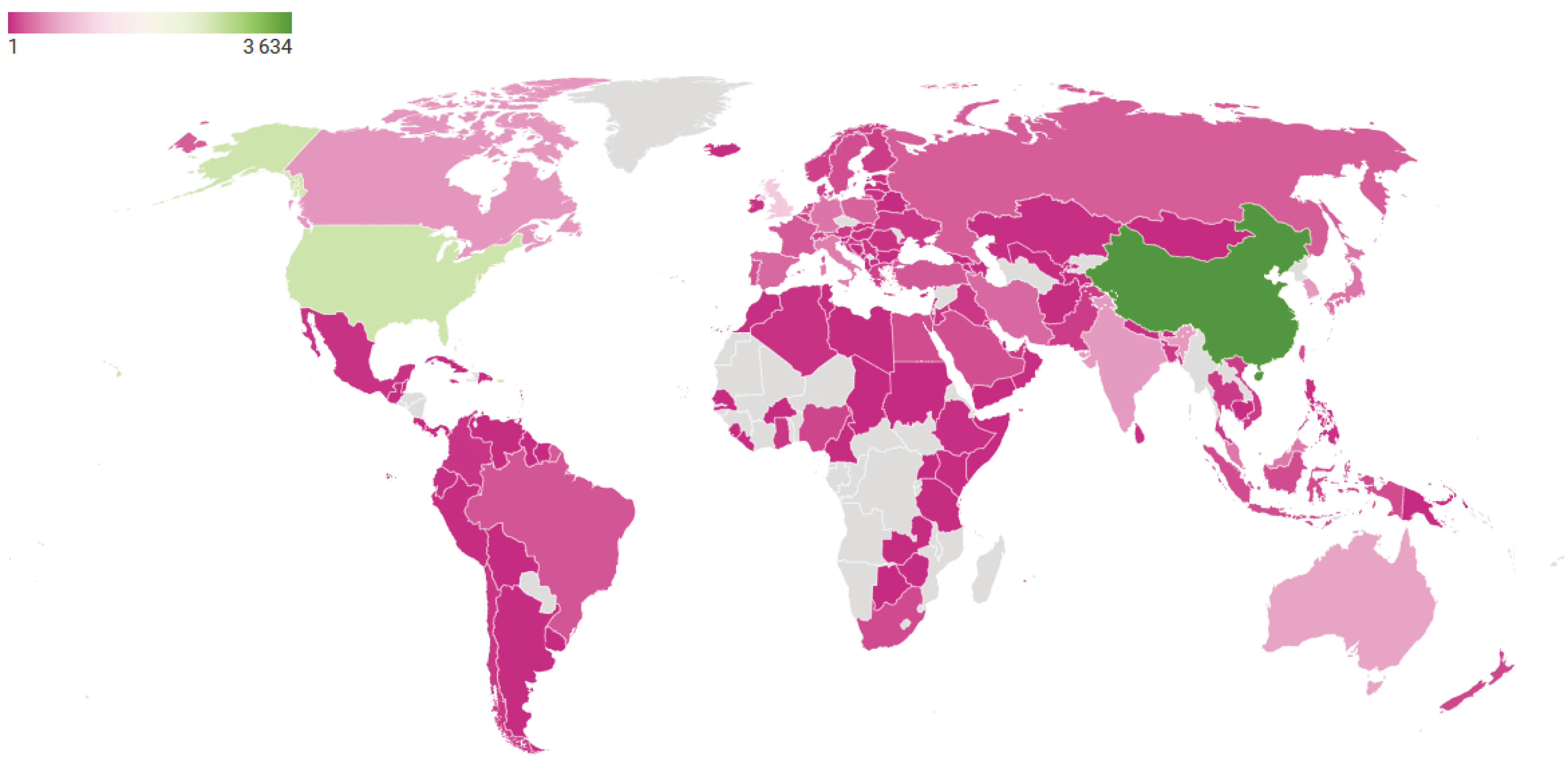


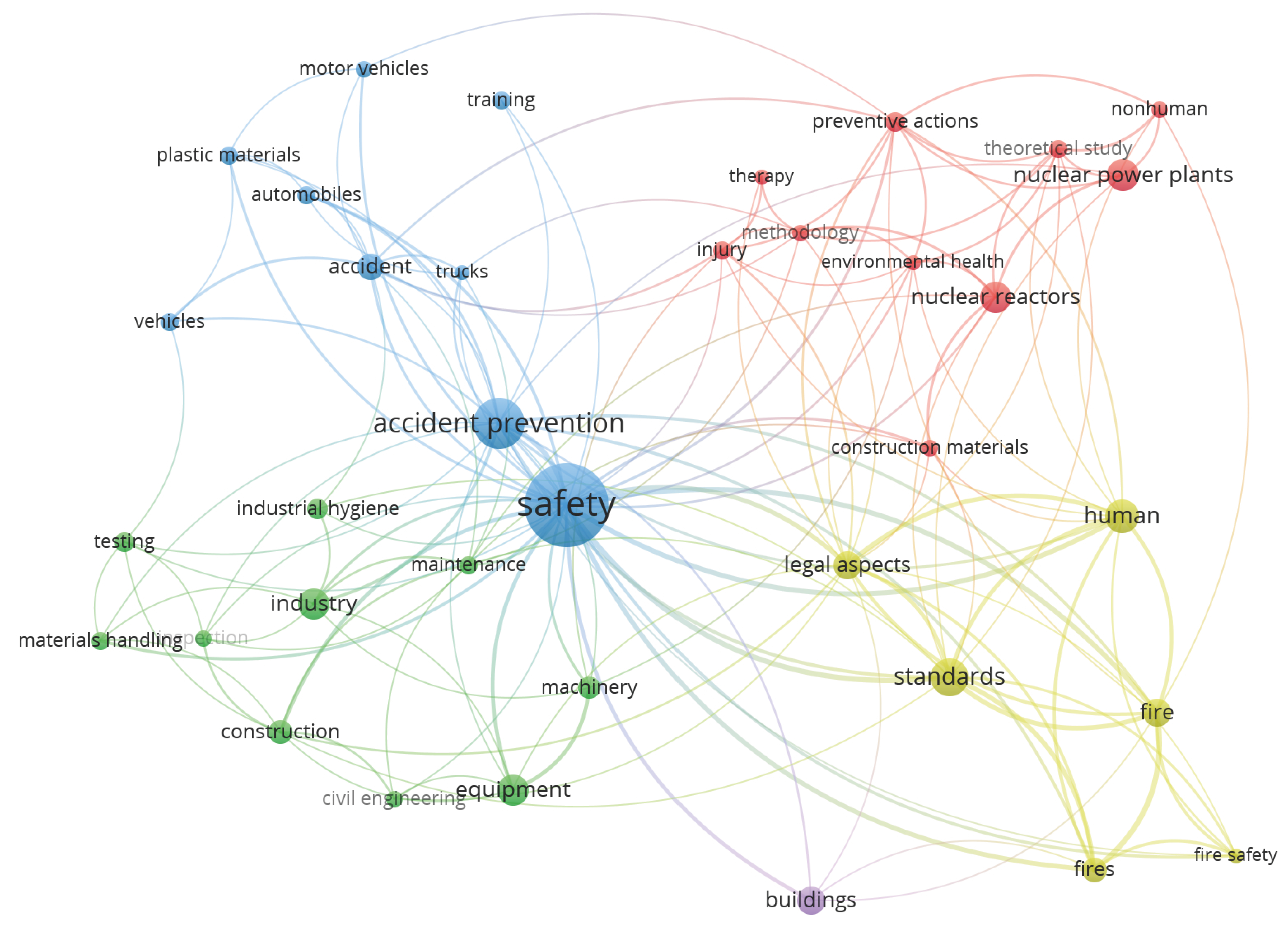
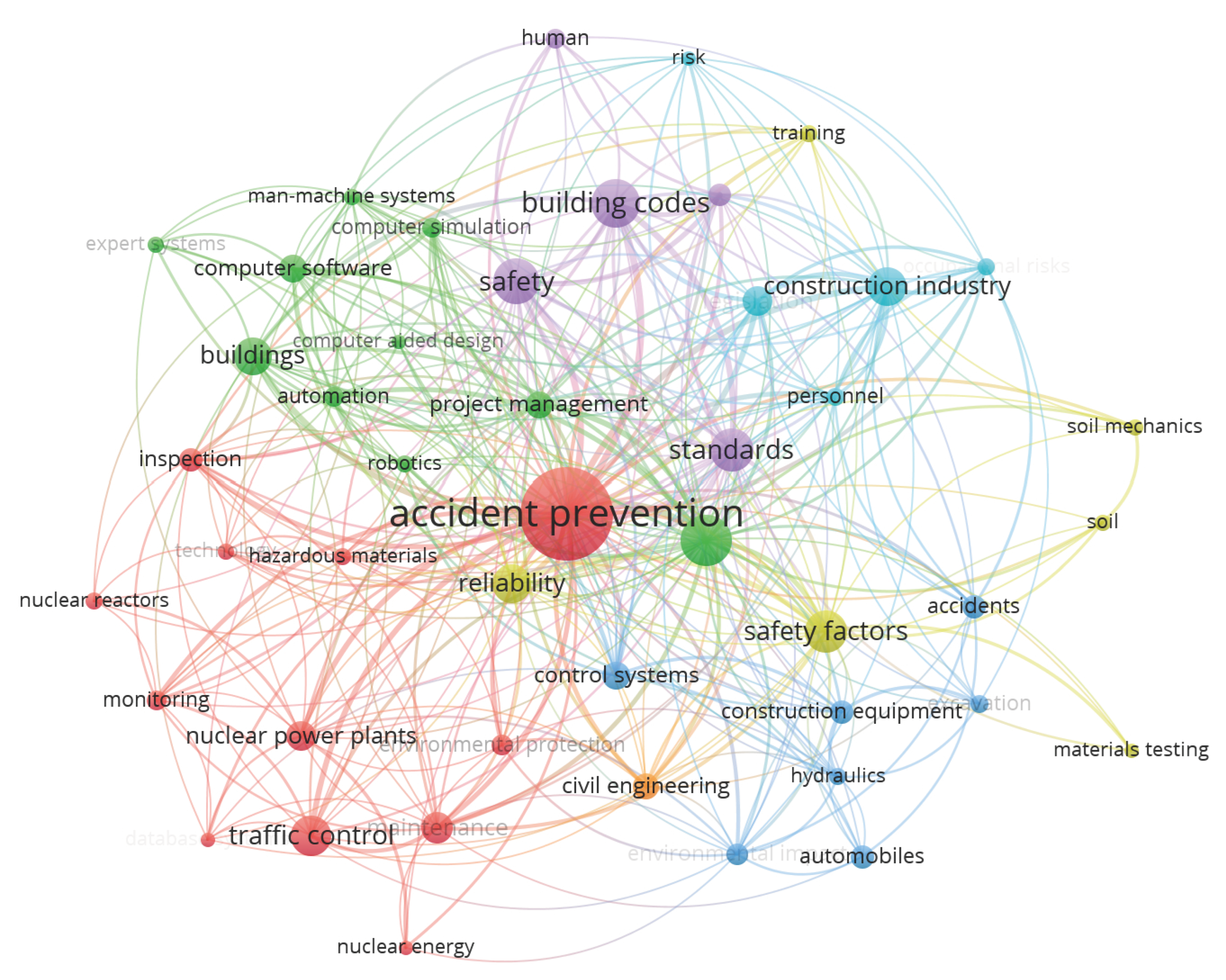
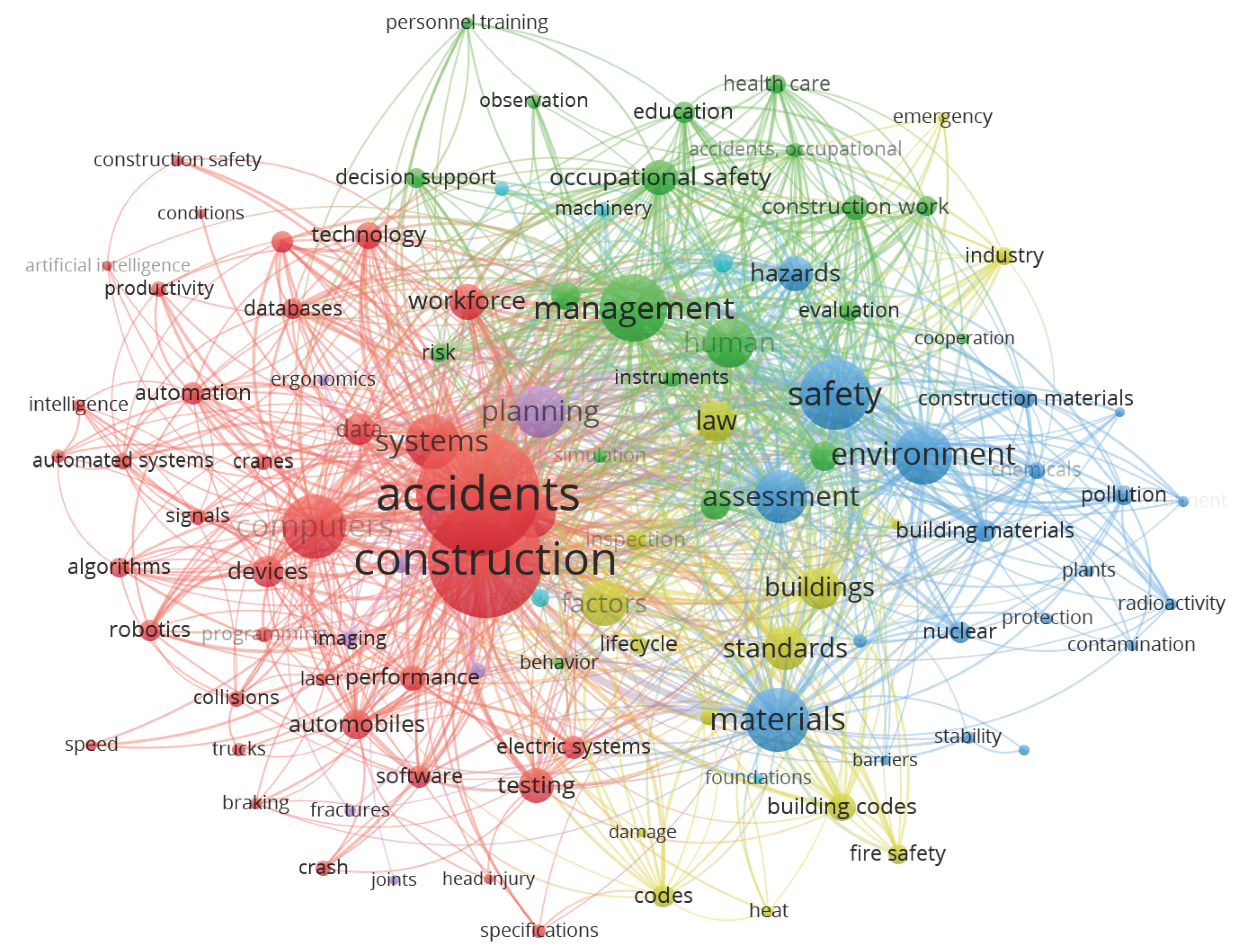
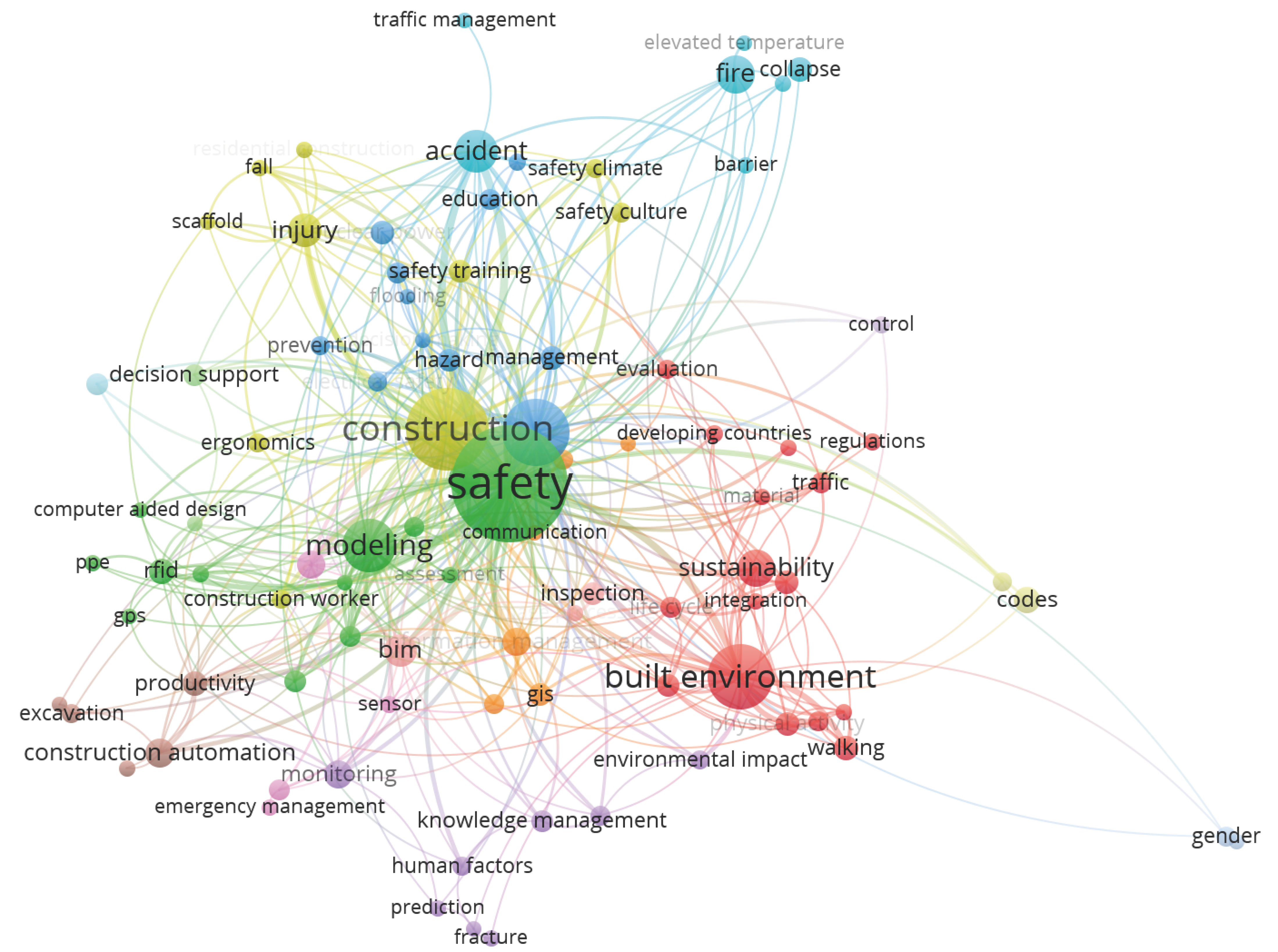

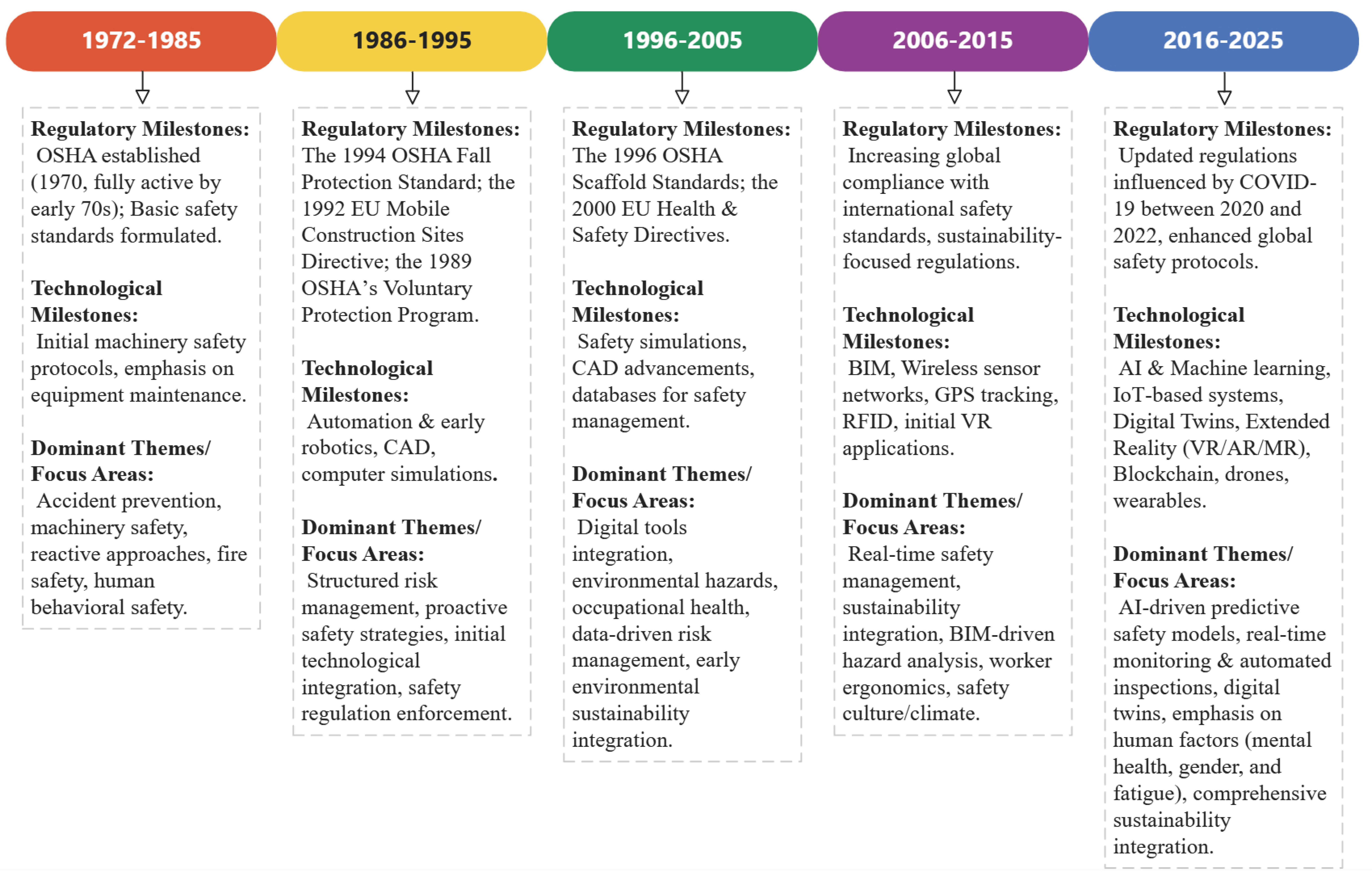

Disclaimer/Publisher’s Note: The statements, opinions and data contained in all publications are solely those of the individual author(s) and contributor(s) and not of MDPI and/or the editor(s). MDPI and/or the editor(s) disclaim responsibility for any injury to people or property resulting from any ideas, methods, instructions or products referred to in the content. |
© 2025 by the authors. Licensee MDPI, Basel, Switzerland. This article is an open access article distributed under the terms and conditions of the Creative Commons Attribution (CC BY) license (https://creativecommons.org/licenses/by/4.0/).
Share and Cite
Olimat, H.; Alwashah, Z.; Abudayyeh, O.; Liu, H. Data-Driven Analysis of Construction Safety Dynamics: Regulatory Frameworks, Evolutionary Patterns, and Technological Innovations. Buildings 2025, 15, 1680. https://doi.org/10.3390/buildings15101680
Olimat H, Alwashah Z, Abudayyeh O, Liu H. Data-Driven Analysis of Construction Safety Dynamics: Regulatory Frameworks, Evolutionary Patterns, and Technological Innovations. Buildings. 2025; 15(10):1680. https://doi.org/10.3390/buildings15101680
Chicago/Turabian StyleOlimat, Hosam, Zaid Alwashah, Osama Abudayyeh, and Hexu Liu. 2025. "Data-Driven Analysis of Construction Safety Dynamics: Regulatory Frameworks, Evolutionary Patterns, and Technological Innovations" Buildings 15, no. 10: 1680. https://doi.org/10.3390/buildings15101680
APA StyleOlimat, H., Alwashah, Z., Abudayyeh, O., & Liu, H. (2025). Data-Driven Analysis of Construction Safety Dynamics: Regulatory Frameworks, Evolutionary Patterns, and Technological Innovations. Buildings, 15(10), 1680. https://doi.org/10.3390/buildings15101680







